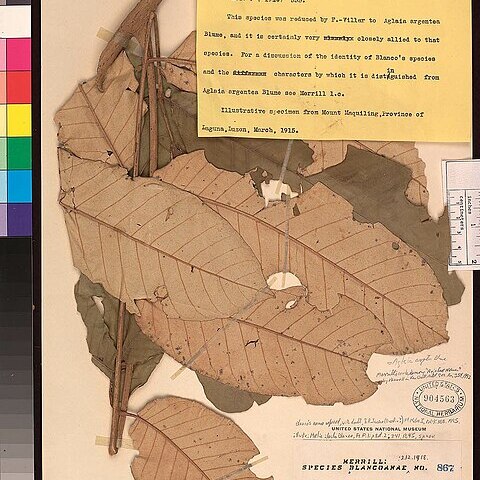Tree up to 30 m, sometimes flowering and fruiting at 4.5 m. Bole up to 18 m, up to 60 cm in diam.; with buttresses to 1 m high and to 1 m out, c. 4 cm thick. Bark smooth, brown or greyish-green, longitudinally lenticellate; inner bark white, yellow or brown; sapwood pale brown, brown or reddish-brown; latex white, when present. Twigs stout, thickly covered with pale brown or white peltate scales which have a darker centre. Leaves in spirals particularly towards the ends of the twigs where they are close to-gether, imparipinnate, 17–112 cm long and 14–75 cm wide; petiole 4–41 cm, petiole, rachis and petiolules ridged and with indumentum like the twigs. Leaflets 9–19, 4.5–30 (-33) by 1.5–11(–14) cm, often shiny above, subcoriaceous, acuminate at apex, usu-ally rounded to an asymmetrical subcordate base, sometimes cuneate, especially on the termina1 leaflet, both surfaces covered with peltate scales when young, when mature upper surface glabrous, the lower surface thickly covered with white peltate scales with few to numerous brown peltate scales interspersed, both types of scales often having a shortly fimbriate margin; veins 11–25 on each side; petiolules 5–10 mm on lateral leaflets, 10–120 mm on terminal leaflets. Inflorescence up to 60 cm long and 60 cm wide, in the axils of the leaves near the apex of the shoot; peduncle up to 15 cm, peduncle, rachis, branches, pedicels and calyx with indumentum like the twigs. Male and female flowers similar, 2–4 mm long and 1.5–2.5 mm wide, ellipsoid, sessile or occasionally with pedicels up to 2.5 mm long. Petals 5, with some scales on the outside when young. Staminal tube shorter than the corolla, obovoid, aperture 0.5–0.6 mm across with an entire or shallowly 5-lobed margin, anthers 5, ovoid, included or just protruding. In-fructescence 20–50 cm long, 25–35 cm wide; peduncle c. 14 cm, the peduncle, rachis and branches with indumentum like the twigs. Fruits 3–3.5 cm long and 2–3 cm wide, ovoid or obovoid, with a short stipe up to 0.5 cm long, pericarp yellow or brown, den-sely covered with scales like those on the twigs, sometimes glabrescent; latex white; locules 2 (or 3) each containing 0 or 1 seed. Seeds completely surrounded with a soft, white, sweet or sweet-sour aril.
More
Tree to 30 m tall, sometimes with buttresses, sometimes with white latex. Indumentum of pale brown or white peltate scales which have a darker centre, densely covering twigs, petioles, rachis, petiolules, inflorescences and infructescences, lower leaflet surfaces, calyces and fruits. Leaves 60–112 cm long. Leaflets 9–19, 11–30 cm long, 1.5–11 cm wide; veins 11–20 pairs. Inflorescence 16–60 cm long. Flowers 2–4 mm long, 1–3 mm wide. Petals 5, pale yellow. Staminal tube obovoid, c. 1.8 mm long and 1.3 mm wide; aperture c. 0.5 mm across; anthers 5, included. Infructescence 20–50 cm long. Fruits indehiscent, pear-shaped, 1–3.5 cm long, 2–2.5 cm wide; pericarp white or yellow. Locules 2 (or 3), each with 0 or 1 seed. Seeds with a complete, thin, yellowish white sweet-sour aril.
An evergreen tree. It grows 30 m tall. The trunk is straight. It is 60 cm across. The branches are high up. It can have buttresses 1 m tall. The leaves are 1 m long. It has leaflets along the stalk. The leaflets are 5-30 cm long by 2-11 cm wide. They are pale brown underneath. Young shoots have short brown hairs. The flower are 2-3 cm across. The fruit are about 3 cm long by 2-3 cm wide. They are cream to brown and have pale brown scales.
A subcanopy to canopy tree in primary, secondary and riverine forest, evergreen or semi-evergreen, on granite, basalt, sandstone, coral sand, clay or limestone; at elevations from sea level up to 1,200 metres.
More
It is a tropical plant. It grows from sea level to 150 m above sea level. It grows in rainforest. In Indonesia it grows between sea level and 1,200 m above sea level. In Townsville arboretum.
Grows on alluvial soil, in semi-evergreen riverine vine forest, coastal riverine rainforest, ridge-top rainforest to 150 m alt. and rarely in floodplain rainforest.


